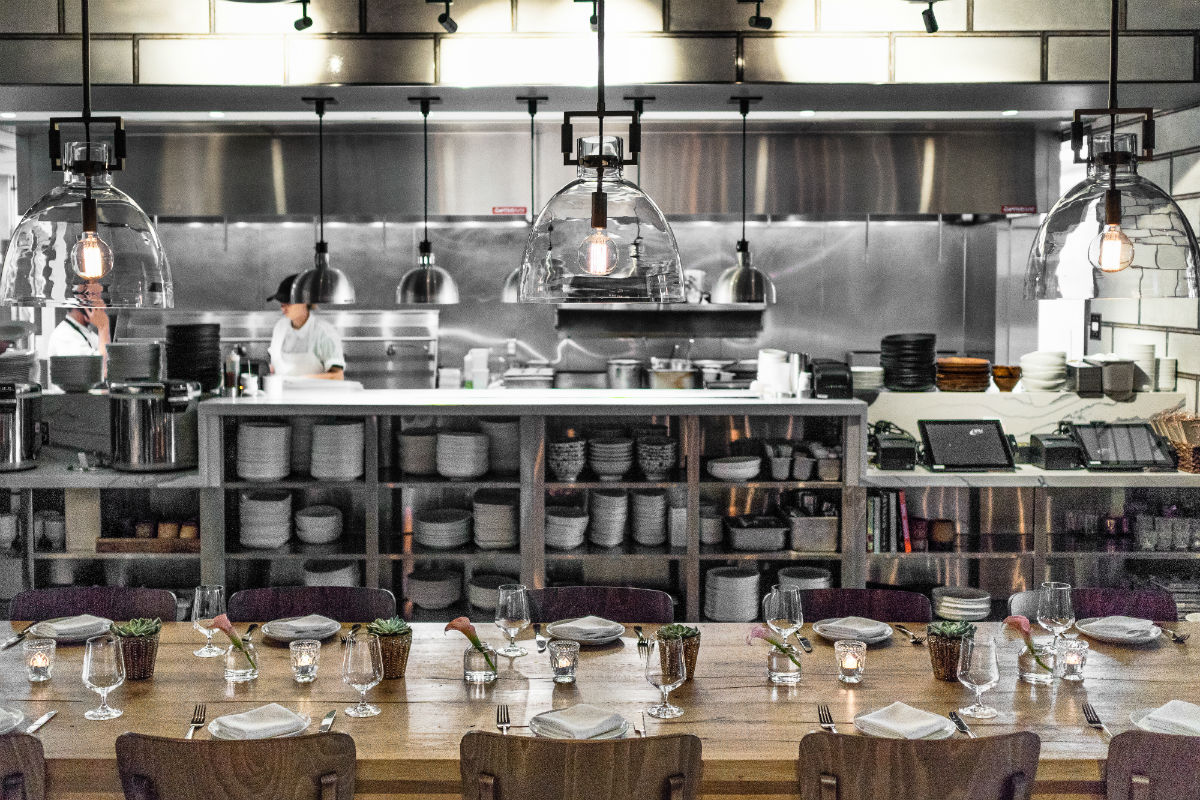At Shea, we pride ourselves on staying on top of what’s happening in design news. It helps us keep tabs on what’s fresh, inspiring, and happening in the world—and we make a few headlines of our own, too. Here are some recent articles delving into design, experience, and what’s buzzing in our community:
“Open Kitchen Design: Form and Function Meet Art” – Foodservice Equipment & Supplies:
As consumers crave more transparency from their eateries post-pandemic, open kitchens may continue their meteoric rise—but with more attention than ever to working those kitchens into the restaurant’s design in a sleek, functional way. It’s about working backwards, starting with what you don’t want guests to see (dish room, cleaning closets, floors), and moving forward to the display (the theater of cooking and plating at countertops that are waist-high or taller). Designers also need to take the kitchen design elements themselves into account, ensuring that the kitchen feels like part of the restaurant rather than a stainless-steel behemoth plunked in its center. Functionality is also important, with noise control, flow, and custom appliances all designed and created to best serve the restaurant’s operations.
“Shea to Spearhead Minneapolis Club Redesign” – Shea:
A roundup of news on the reimagination of the Minneapolis Club, led by Shea.
“Inside Blackberry Farm’s Stylish Push Into Real Estate and Home Design” – Architectural Digest:
Legendary rustic-meets-luxury Tennessee resort Blackberry Farm has gone from being a spectacular hotel experience to a full-on juggernaut. This piece dives into the process, a valuable take as more and more destination resorts are looking to expand their offerings. The 35-year-old resort has always been heralded for its design and attention to detail, but has now expanded into private property ownership with Blackberry Farm Real Estate and The Mountain, a nearby second resort. The internal design team has also created its own full-service consultancy, Blackberry Farm Design, to work on both properties as well as the private residences. It’s a true study in concept expansion, with a fully engaging brand and utterly immersive experience for guests, visitors, and owners.
“How to Incorporate Technology Into a Hotel Renovation” – Hotel Management:
With technology more at the forefront of design and retrofitting than ever, hotels are looking to bring the most up-to-date features into their renovations. This story goes into how to bring tech into the guest experience and keep it supported by human interaction, so that hospitality never loses that personal touch. From the basics (boosting Wi-Fi capacity) to ensuring that conference and business areas are fully equipped for webinars and virtual meetings, the piece also examines energy-management technology, and dives into the renovation of the historic Hotel Laguna, where technology upgrades were incorporated into the renovation of a hotel on the National Register of Historic Places.
“New York Loves Outdoor Dining. Here’s How to Keep the Romance Alive.” – New York Times:
Last summer’s hugely creative influx of outdoor restaurants took over the New York streets, and city residents have become used to the in-street dining areas. Critic Pete Wells suggests that a third wave of curbside dining architecture (post-shanty, post-more-refined-space) is coming, with potential to be more permanent, as the city government works on its Open Restaurants project. New Yorkers truly like outdoor dining and the creative aspects of these spaces, and they make the city a more pleasant place—so this piece looks at how government, space, health codes, and financials need to work together to make it all happen, and how it can serve as a model for other cities to adopt a more robust outdoor-dining program. Wells also looks at some of the most successful outdoor-dining designs, from playful rainforest-inspired spots to ones promoting social-justice messages to the sturdiest, most permanent-feeling ones.
“The Benefits of Unassigned Versus Assigned Seating in the Workplace” – Work Design:
Hot-desking. Hoteling. Unassigned seating. Whatever you call it, nixing dedicated workspaces was a pre-pandemic trend that’s gaining more traction as the transformation of the office continues. In order to build more community, many workplaces are focusing on choice in how, when, and where people do their work—and when they’re in-office, that includes the specific space they’re in. With collaborative spaces taking center stage when it comes to allocation and many employees in the office only part-time, companies are reconsidering the need for a dedicated seating plan, favoring an unassigned seating policy that helps create agility and energy. Work Design looks at how some offices have made a new plan work, with lockers for personal and work materials and a reservation system to select seats, along with communal and lounge spaces available as needed.
“Safety + Comfort in Restaurant Design” – Restaurant Development + Design:
Restaurant Development + Design discusses what’s still happening in restaurant design to create flexible, comfortable, and safe environments for diners. Service styles have shifted, with more breathing room in dining areas and an influx of market spaces. Takeout continues to reign, with restaurant designs taking into consideration dedicated areas for pickup that are in keeping with the eatery’s aesthetic. And while plexiglass partitions were a fleeting safety fad, many restaurants are looking for natural partitions, whether it’s glass walls looking into the kitchen or greenery separating tables and booths. And, of course, outdoor dining maintains its new importance, with more pedestrian-friendly spaces, outdoor structures, and well-designed extensions of the interior vibes.
“Preston Spire Gets a New Name and Shea-Designed Offices” – Shea:
Major Minneapolis agency Preston Spire has made a splash with a rebrand and new, Shea-designed office space—we’ve rounded up all the stories giving the scoop.
“Creating the Right Spaces for Your Post-Pandemic Workplace” – Allwork.Space:
To keep up with dynamic workers, even static buildings need to add in flexibility. Corporate clients are looking to maximize productivity with redesigned offices that work for their employees, improving their workplace experience to draw them back to the office and serving what they most need. Activity-Based Workplace Design is a model that bases office floorplans and designs on how people use individual spaces, as well as how they will move between and through them. It’s about considering the flow of the day and the employees, and the different types of work (focus/creative, task, collaboration, social, calls, presentations) that they encounter throughout the day, and creating designs that can best support each. This model is appealing to clients because it can not only boost productivity, but also morale, connection, and energy in the office, and is one to be well-versed in when approaching an office design.
“Live Your Best Hotel Life—Even In Your Own Home” – Food & Wine:
Primarily focused on The Maker in Hudson, New York, Food & Wine explores both the multifunctionality of hotel and hospitality spaces today, as well as potential opportunities for business expansion. The Maker’s founders expanded from lifestyle brands to hospitality and brought the same holistic ethos, with a philosophy of truly hosting people in a fully immersive creative experience. The piece looks at the role artisans can play in making in a space one of a kind, and how hotels can help establish themselves as lifestyle brands by way of partnerships and retail items used in their spaces. The piece also looks at other hotels around the country that have implemented a similar ethos.
July 23, 2021
Shea Links: July

